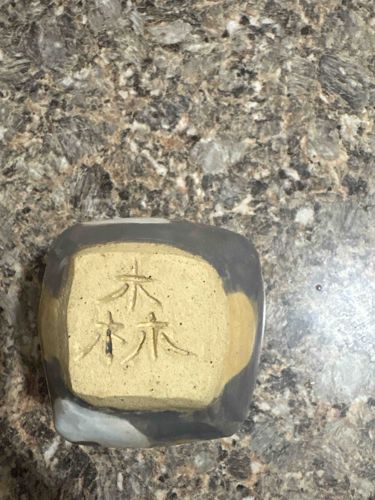
Studio Pottery Teacup or Sake Cup with Japanese Marking
This is a small, handcrafted ceramic vessel, likely a teacup or sake cup, characterized by its rustic, organic aesthetic. The piece appears to be made from stoneware or a similar earthy clay, exhibiting a light-colored, unglazed foot that contrasts with the glazed upper body. The main body of the cup features an irregular, somewhat rounded square shape, which suggests it was hand-formed rather than mass-produced. The exterior glaze is a mottled blend of dark grey, almost black, and warm beige or light brown tones. This dual-tone glazing creates an interesting visual texture and pattern, with the darker glaze dominating in some areas and swirling into the lighter shades in others. The base, or foot, of the cup is left unglazed, revealing the natural buff color of the clay. Incised into this unglazed foot are three distinct Japanese characters, appearing to be '森木' or 'Mori' in some contexts, which is a common surname or can mean 'forest'. These marks are deeply cut, suggesting they were applied by hand before firing. The craftsmanship indicates a studio pottery piece, valuing uniqueness over perfect symmetry. The visible condition is good; there are no obvious chips, cracks, or repairs. The somewhat rough finish of the foot area is consistent with handmade pottery. Its style points to a mid-20th century to contemporary Japanese or Japanese-inspired pottery tradition, emphasizing natural materials and a wabi-sabi aesthetic.
AI-Generated Appraisal Disclaimer
Estimated Value
$150-250
Basic Information
Category
Ceramics
Appraised On
November 15, 2025
Estimated Value
$150-250
Item Description
This is a small, handcrafted ceramic vessel, likely a teacup or sake cup, characterized by its rustic, organic aesthetic. The piece appears to be made from stoneware or a similar earthy clay, exhibiting a light-colored, unglazed foot that contrasts with the glazed upper body. The main body of the cup features an irregular, somewhat rounded square shape, which suggests it was hand-formed rather than mass-produced. The exterior glaze is a mottled blend of dark grey, almost black, and warm beige or light brown tones. This dual-tone glazing creates an interesting visual texture and pattern, with the darker glaze dominating in some areas and swirling into the lighter shades in others. The base, or foot, of the cup is left unglazed, revealing the natural buff color of the clay. Incised into this unglazed foot are three distinct Japanese characters, appearing to be '森木' or 'Mori' in some contexts, which is a common surname or can mean 'forest'. These marks are deeply cut, suggesting they were applied by hand before firing. The craftsmanship indicates a studio pottery piece, valuing uniqueness over perfect symmetry. The visible condition is good; there are no obvious chips, cracks, or repairs. The somewhat rough finish of the foot area is consistent with handmade pottery. Its style points to a mid-20th century to contemporary Japanese or Japanese-inspired pottery tradition, emphasizing natural materials and a wabi-sabi aesthetic.
Related Tags
Get Your Items Appraised
Instant estimates of your treasures with AI-powered instant appraisals